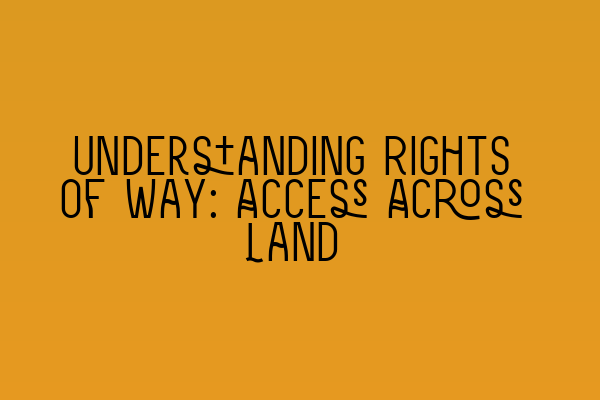Understanding Rights of Way: Access Across Land
As a property owner or potential buyer, it is crucial to have a thorough understanding of the rights of way that may affect your land. Rights of way provide the legal permission to cross or pass through someone else’s property, granting access to a particular area. They are a common occurrence in both rural and urban settings, and can significantly impact the value and use of a property.
In this blog post, we will delve into the intricacies of rights of way, covering everything from types of rights of way to the legal implications they entail. By the end, you’ll be equipped with the knowledge necessary to navigate this complex area of property law.
Types of Rights of Way
Rights of way can take various forms, each with its own characteristics and limitations. Let’s explore the most common types:
1. Public Rights of Way:
Public rights of way are established under statutory legislation and are accessible to the general public. They are typically footpaths, bridleways, or byways, and allow people to pass through private land for specific purposes, such as walking, cycling, or horse riding. These rights are often recorded in official maps and can only be altered or extinguished through a legal process.
2. Private Rights of Way:
Private rights of way, as the name suggests, are restricted to specific individuals or groups of people. These rights are usually granted through legal documents, such as deeds or agreements, and provide access to designated areas. Unlike public rights of way, private rights of way can be more easily altered or terminated by the landowners or the beneficiaries, subject to any contractual obligations.
3. Easements:
An easement is a legal right to use or enjoy another person’s property for a specific purpose. It may include rights of way, but can also encompass other rights, such as the right to light or the right to access utilities. Easements are typically created through a written agreement between the landowner and the party benefiting from the easement, and they bind subsequent owners of the land.
Legal Considerations
Understanding the legal implications of rights of way is essential to avoid disputes and ensure the smooth use of your property. Here are some important considerations:
1. Documentation:
Before purchasing a property or granting a right of way, it is crucial to review the relevant legal documentation. This may include deeds, agreements, or maps that establish and define the rights of way. Consulting a property lawyer or solicitor can help you interpret these documents and determine the scope and extent of the rights.
2. Maintenance Obligations:
Even if a right of way exists, it is important to understand who is responsible for its maintenance. In some cases, the burden may fall on the landowner, while in others, it may be shared among multiple parties. Clarifying these obligations can help avoid disputes and ensure the proper upkeep of the access route.
3. Disputes and Resolution:
Disagreements relating to rights of way can arise for various reasons, such as excessive use, blocked access, or changes in land use. If such conflicts occur, it is advisable to seek legal advice and explore mediation or negotiation options before escalating the matter to court. Resolving disputes amicably can save both time and money for all parties involved.
4. Impact on Property Value:
Rights of way can affect the value and marketability of a property. While some rights of way may enhance the desirability of a property, others may have a negative impact. Understanding the implications of rights of way on property value is crucial, especially when buying or selling land.
Conclusion
Rights of way play a significant role in property law, allowing individuals or the public access to specific areas of land. It is important for property owners and buyers to have a comprehensive understanding of rights of way and their legal implications. By reviewing the relevant documentation, clarifying maintenance obligations, and seeking legal advice when necessary, you can navigate this complex area of property law successfully.
If you found this article helpful, you may also be interested in our related articles:
– SQE 1 Practice Exam Questions
– SQE 1 Practice Mocks FLK1 FLK2
– SQE 2 Preparation Courses
– SQE 1 Preparation Courses
– SRA SQE Exam Dates
For more information about property law and land law, please don’t hesitate to contact SQE Property Law & Land Law, where our team of expert solicitors and professionals can assist you with any legal inquiries or concerns you may have.
